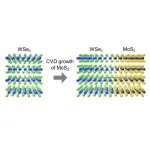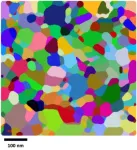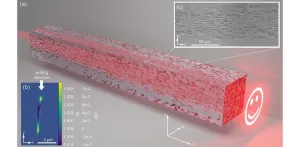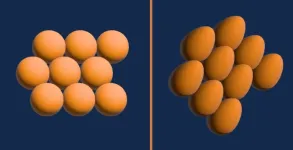(Press-News.org) If more people have access to health insurance, we have to be sure the death rates of those with certain chronic conditions are decreasing.
This is one of the statements Gregory Peck, an acute care surgeon and associate professor at Rutgers Robert Wood Johnson Medical School, will be researching on behalf of the National Institute of Diabetes and Digestive and Kidney Diseases (NIDDK) at the National Institutes of Health.
Funded by NIH grants totaling more than $1 million through a recent two-year award from the New Jersey Alliance for Clinical and Translational Science (NJ ACTS), a Rutgers hub of the National Center for Advancing Translation Science, and now a four-year award from the NIDDK, Peck is on average one of just two critical care surgeons funded nationally annually creating new models of health for NIH consideration.
Peck recently published two studies investigating death rates for gallstone disease, a disease of the abdomen that causes right-sided belly pain after eating, which share risk factors with other deadly diseases. His study, published in Gastro Hep Advances, found that between 2009 and 2018 the number of deaths of people in New Jersey with diagnosed gallstone disease (1,580) remained steady and did not improve, and that deaths in Latinos ages 65 and older potentially increased.
His study in the Journal of Surgical Research found that after Medicaid expansion in 2014 as compared to before, the amount of emergency surgery to remove the gallbladders for gallstone disease decreased in the state overall, but increased in people with Medicaid. While fatality from gallbladder removal surgery decreased for those 65 or older, there was increased death from surgery in the younger population and a trend of more death in the population with Medicaid. Further, the relatively decreased amount of gallbladder removal surgery occurring in ambulatory outpatient care centers did not necessarily help this.
Peck discusses the implications of the findings on a new shift in healthcare to prevention model.
Why did you focus on gallstone disease?
As a metabolic disease, gallstone disease is also linked to heart disease, cancer, diabetes, obesity and a sedentary lifestyle. In fact, heart disease, which is the No. 1 killer in America, and gallstone disease, which is the No. 1 digestive disease requiring surgery in America, share the risk factors of high levels of bad cholesterol type and obesity.
How do these studies inform public policy?
The amount of people dying with gallstone disease – most of whom require surgery – over the past decade has not gotten better. That’s 160 people a year who still are dying from a preventable death such as gallstone disease. Making progress is what this type of epidemiologic study focuses on, and concerningly, we might not have made good progress.
If Medicaid expansion didn’t positively affect the death rate of people with gallstone disease and we see it increase specifically in older Latino populations, we need to be asking if we are helping people of color and those who live in communities with lower socioeconomic status improve health or treating them sooner to prevent emergency surgery and especially decreasing death from emergency surgery. Insurance expansion is certainly needed, but we have to ensure the action specific pieces of policy impact the population requiring surgery in a patient-centered way.
The real goal is preventing the disease from even occurring. When we pass public health policy, we need to advocate for preventive care that reaches people through their community. Right now, the findings show that we might just be providing people with insurance cards who find themselves still needing to use the emergency department. Instead, that insurance should help them visit their primary care doctor, who can help them make changes like decreasing their bad cholesterol levels, which contribute to gallstone disease, and help them access care in ambulatory surgery centers sooner.
We need to cultivate preventive healthcare rather than ballooning the investment in emergency healthcare, which does not solve current inequities.
What other steps to improve access to care should be taken?
We propose a novel population health approach that shifts from the reactive treatments of emergency disease to proactive prevention. One place to start is increasing access to appropriate outpatient elective healthcare for underrepresented groups with barriers to preventive care, such as by increasing health insurance that incentivizes the behaviors toward improved health. A first step for my research group is to focus on diseases that currently require as much emergency as elective care, such as gallstone disease, and understand this by understanding who presents to the hospital, as to dial this back into the community level, to decrease hospital care.
In addition, in primary care, laboratory, radiology or ambulatory care settings we need to improve communication with people with low English proficiency – especially how well prevention is explained in a patient’s primary language. Language barriers might also prevent them from understanding the importance of cholesterol or blood pressure control over the one, two and three decades of life, or how they find access to diagnostic tests or treatment needed earlier.
How is Rutgers working to increase primary care knowledge in underserved communities?
Shawna Hudson, the co-director of community engagement for NJ ACTS, and my research mentor, is researching how representatives rooted in the community can help healthcare providers and researchers better understand how we can use community engagement to involve people in a communities’ preventive care as to decrease risk factors for chronic disease before they need hospital-based care and, more importantly, emergency surgery.
One initiative is the Community Engagement Virtual Salons, which help researchers and health care providers at NJ ACTS engage with patients and community members about how biomedical and clinical research leads to action through understanding disease and then enacting policy. In these sessions, the public serves as experts to provide feedback from a community perspective. This allows the medical profession to build relationships with community partners and increase the culturally sensitive participation of hard-to-reach populations.
END
Achieving prevention and health, rather than more healthcare
Rutgers is researching a new health care model that emphasizes primary care and prevention over emergency care in underserved communities
2023-04-23
ELSE PRESS RELEASES FROM THIS DATE:
Inflammation ‘brake’ gene may help reveal outcomes of kidney disease
2023-04-23
A discovery about gene variants of an inflammation ‘brake’ brings scientists a step closer to personalised treatment for patients at risk of kidney disease and kidney failure.
Researchers at the Garvan Institute of Medical Research, University of New South Wales, Sydney and Westmead Hospital, found that common genetic variants of TNFAIP3, which increase inflammation in the body, can paradoxically protect the kidneys from damage in the short term.
“We wanted to investigate whether inherited differences in how people regulate inflammation could lead to better or worse kidney health outcomes,” says Professor Shane ...
Too much insulin can be as dangerous as too little
2023-04-22
Just over a century has passed since the discovery of insulin, a time period during which the therapeutic powers of the hormone have broadened and refined. Insulin is an essential treatment for type 1 diabetes and often for type 2 diabetes, as well. Roughly 8.4 million Americans use insulin, according to the American Diabetes Association.
One hundred years of research have greatly advanced medical and biochemical understanding of how insulin works and what happens when it is lacking, but the reverse, how potentially fatal insulin hyper-responsiveness is prevented, has remained a persistent mystery.
In a new study, published in the April 20, 2023 online edition ...
From sheets to stacks, new nanostructures promise leap for advanced electronics
2023-04-22
Tokyo, Japan – Scientists from Tokyo Metropolitan University have successfully engineered multi-layered nanostructures of transition metal dichalcogenides which meet in-plane to form junctions. They grew out layers of multi-layered structures of molybdenum disulfide from the edge of niobium doped molybdenum disulfide shards, creating a thick, bonded, planar heterostructure. They demonstrated that these may be used to make new tunnel field-effect transistors (TFET), components in integrated circuits with ultra-low power consumption.
Field-effect transistors ...
How alcohol consumption contributes to chronic pain
2023-04-21
LA JOLLA, CA—Chronic alcohol consumption may make people more sensitive to pain through two different molecular mechanisms—one driven by alcohol intake and one by alcohol withdrawal. That is one new conclusion by scientists at Scripps Research on the complex links between alcohol and pain.
The research, published in the British Journal of Pharmacology on April 12, 2023, also suggests potential new drug targets for treating alcohol-associated chronic pain and hypersensitivity.
“There is an urgent need to better ...
Want to make better materials? Read between the lines. Or the “grain boundaries,” as they’re known in materials science.
2023-04-21
The orientations of these infinitesimally small separations between individual “grains” of a polycrystalline material have big effects. In a material such as aluminum, these collections of grains (called microstructures) determine properties such as hardness.
New research is helping scientists better understand how microstructures change, or undergo “grain growth,” at high temperatures.
A team of materials scientists and applied mathematicians developed a mathematical model that more accurately describes such microstructures by integrating data that can be identified from highly magnified ...
New injectable cell therapy developed by WFIRM scientists could resolve osteoarthritis
2023-04-21
WINSTON-SALEM, NC, April 21, 2023 – Wake Forest Institute for Regenerative Medicine (WFIRM) scientists have created a promising injectable cell therapy to treat osteoarthritis that both reduces inflammation and also regenerates articular cartilage.
Recently identified by the Food and Drug Administration as a public health crisis, osteoarthritis affects more than 520 million people worldwide who deal with pain and inflammation. Osteoarthritis is typically induced by mechanical or traumatic stress in the joint, leading to damaged cartilage that cannot be repaired naturally.
“Without better understanding of what drives the initiation and progression of osteoarthritis, effective treatment ...
New approach to developing efficient, high-precision 3D light shapers
2023-04-21
Modern-day technologies like optical computing, integrated photonics, and digital holography require light signals to be manipulated in three dimensions. To achieve this, it is necessary to be able to shape and guide the flow of light according to its desired application. Given that light flow within a medium is governed by the refractive index, specific tailoring of the refractive index is needed to realize control of the light path within the medium.
To this end, scientists have developed what are called “aperiodic photonic ...
New McCombs Award honors Herb Miller
2023-04-21
New McCombs Award Honors Herb Miller
Professional Faculty Impact Award recognizes exceptional contributions of teaching, service, and mentorship.
Associate Professor of Instruction Herb Miller is the namesake and the first recipient of the new McCombs School of Business Marketing Department Herbert A. Miller Jr. Professional Faculty Impact Award.
The award was made possible by William Cunningham, who served as McCombs dean, UT Austin president, and University of Texas System chancellor, as a way to recognize and honor the professional faculty in the department of marketing.
“In ...
Putting hydrogen on solid ground: Simulations with a machine learning model predict a new phase of solid hydrogen
2023-04-21
Hydrogen, the most abundant element in the universe, is found everywhere from the dust filling most of outer space to the cores of stars to many substances here on Earth. This would be reason enough to study hydrogen, but its individual atoms are also the simplest of any element with just one proton and one electron. For David Ceperley, a professor of physics at the University of Illinois Urbana-Champaign, this makes hydrogen the natural starting point for formulating and testing theories of matter.
Ceperley, also a member of the Illinois Quantum ...
Researchers develop safety monitoring system for construction sites
2023-04-21
University of Houston computer scientists have developed a new system to keep construction workers safe at job sites. Their findings and process are laid out in a study published in the research journal Applied Sciences.
According to the Occupational Safety and Health Administration, 4,764 workers died on the job in 2020. Employees in construction and extraction occupations accounted for 20% of those deaths. Many were struck by a vehicle or mobile machinery on construction sites. Although the construction industry has enlisted the help of safety experts, a great number of fatalities and injuries still occur.
“The point of our research project was to enhance safety of workers ...
LAST 30 PRESS RELEASES:
Survey reveals ethical gaps slowing AI adoption in pediatric surgery
Stimulant ADHD medications work differently than thought
AI overestimates how smart people are, according to HSE economists
HSE researchers create genome-wide map of quadruplexes
Scientists boost cell "powerhouses" to burn more calories
Automatic label checking: The missing step in making reliable medical AI
Low daily alcohol intake linked to 50% heightened mouth cancer risk in India
American Meteorological Society announces Rick Spinrad as 2026 President-Elect
Biomass-based carbon capture spotlighted in newly released global climate webinar recording
Illuminating invisible nano pollutants: advanced bioimaging tracks the full journey of emerging nanoscale contaminants in living systems
How does age affect recovery from spinal cord injury?
Novel AI tool offers prognosis for patients with head and neck cancer
Fathers’ microplastic exposure tied to their children’s metabolic problems
Research validates laboratory model for studying high-grade serous ovarian cancer
SIR 2026 delivers transformative breakthroughs in minimally invasive medicine to improve patient care
Stem Cell Reports most downloaded papers of 2025 highlight the breadth and impact of stem cell research
Oxford-led study estimates NHS spends around 3% of its primary and secondary care budget on the health impacts of heat and cold in England
A researcher’s long quest leads to a smart composite breakthrough
Urban wild bees act as “microbial sensors” of city health.
New study finds where you live affects recovery after a hip fracture
Forecasting the impact of fully automated vehicle adoption on US road traffic injuries
Alcohol-related hospitalizations from 2016 to 2022
Semaglutide and hospitalizations in patients with obesity and established cardiovascular disease
Researchers ‘listen in’ to embryo-mother interactions during implantation using a culture system replicating the womb lining
How changing your diet could help save the world
How to make AI truly scalable and reliable for real-time traffic assignment?
Beyond fragmented markets: A new framework for efficient and stable ride-pooling
Can shape priors make road perception more reliable for autonomous driving?
AI tracks nearly 100 years of aging research, revealing key trends and gaps
Innovative techniques enable Italy’s first imaging of individual trapped atoms
[Press-News.org] Achieving prevention and health, rather than more healthcareRutgers is researching a new health care model that emphasizes primary care and prevention over emergency care in underserved communities





